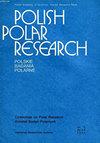东南极洲张伯果站附近积雪同位素和化学成分的季节性特征
IF 0.8
4区 地球科学
Q4 ECOLOGY
引用次数: 2
摘要
本文章由计算机程序翻译,如有差异,请以英文原文为准。
Seasonality of isotopic and chemical composition of snowpack in the vicinity of Jang Bogo Station, East Antarctica
: Seasonal variations of the isotopic and chemical compositions of snowpits can provide useful tools for dating the age of the snowpit and examining the sources of aerosol. Based on the seasonal layers with δD and δ 18 O maxima and minima, it was determined that the snowpit, conducted in the vicinity of the Jang Bogo Station in Antarctica, contained snow deposited over a three-year period (2008–2010). Distinct seasonal variations of stable water isotopes were observed, with a slope of 8.2 from the linear isotopic relationship between oxygen and hydrogen, which indicates that the snow accumulated during three years without a significant post-depositional process. The positive correlations (r > 0.85) between Na + and other ions in the winter period and the positive relationship with the concentrations of the methanesulphonic acid (MSA) and non-sea salt sulfate (nssSO 42– ) in the warm period (r = 0.6, spring to summer) indicate the significant contributions of an oceanic source to the snowpit. Based on principal component analysis, the isotopic and chemical variables were classified into species representing input of sea-salt aerosol and suggesting potential seasonal markers. This study will support further investigations using ice cores in this region.
求助全文
通过发布文献求助,成功后即可免费获取论文全文。
去求助
来源期刊

Polish Polar Research
ECOLOGY-GEOSCIENCES, MULTIDISCIPLINARY
CiteScore
2.00
自引率
7.70%
发文量
0
审稿时长
>12 weeks
期刊介绍:
The quarterly Polish Polar Research edited by the Committee on Polar Research of the Polish Academy of Sciences is an international journal publishing original research articles presenting the results of studies carried out in polar regions.
All papers are peer-reviewed and published in English.
The Editorial Advisory Board includes renowned scientist from Poland and from abroad.
 求助内容:
求助内容: 应助结果提醒方式:
应助结果提醒方式:


